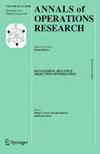最大几何平均数标准:重温马科维茨-萨缪尔森之争:调查与分析
IF 4.4
3区 管理学
Q1 OPERATIONS RESEARCH & MANAGEMENT SCIENCE
引用次数: 0
摘要
根据几乎一级随机支配(AFSD)规则,只对应于经济上相关的偏好,对于无限期限,马科维茨和萨缪尔森的(理论上的)主张是不完整的。然而,对于长期但有限期限的实际情况,即股票-债券投资组合,马科维茨是正确的,因为我们发现在所有风险厌恶参数下,MGM投资组合都与最优近视投资组合相吻合。对于(α大于1.7),只要投资期限是12-15年或更长,MGM投资组合就会通过AFSD规则支配所有最优近视投资组合。本文章由计算机程序翻译,如有差异,请以英文原文为准。

The maximum geometric mean criterion: revisiting the Markowitz–Samuelson debate: survey and analysis
By the Almost First-degree Stochastic Dominance (AFSD) rule, corresponding only to economically relevant preferences, for an infinite horizon the \(theoretical\) claim of both Markowitz and Samuelson is not intact. However, for the practically more relevant case of the long but finite horizon, with stocks-bonds portfolios, Markowitz \(empirically\) is right as we find that the MGM portfolio coincides with the optimal myopic portfolio for all risk aversion parameters \(\alpha < 1.7\). For \(\alpha \ge 1.7\) the MGM portfolio dominates by AFSD rule all optimal myopic portfolios, as long as the investment horizon is 12–15 years or longer.
求助全文
通过发布文献求助,成功后即可免费获取论文全文。
去求助
来源期刊

Annals of Operations Research
管理科学-运筹学与管理科学
CiteScore
7.90
自引率
16.70%
发文量
596
审稿时长
8.4 months
期刊介绍:
The Annals of Operations Research publishes peer-reviewed original articles dealing with key aspects of operations research, including theory, practice, and computation. The journal publishes full-length research articles, short notes, expositions and surveys, reports on computational studies, and case studies that present new and innovative practical applications.
In addition to regular issues, the journal publishes periodic special volumes that focus on defined fields of operations research, ranging from the highly theoretical to the algorithmic and the applied. These volumes have one or more Guest Editors who are responsible for collecting the papers and overseeing the refereeing process.
 求助内容:
求助内容: 应助结果提醒方式:
应助结果提醒方式:


